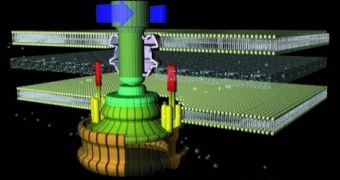Generally speaking, a motor may be defined as a device that consumes energy in one form and converts it into motion or mechanical work; for example, many protein-based molecular motors harness the chemical free energy released by the hydrolysis of ATP in order to perform mechanical work. In terms of energetic efficiency, these types of motors can be superior to currently available man-made motors.
Physicists from the University of Georgia have developed a new way to create "natural motors" for tiny machines.
Molecular motors are biological "nanomachines" that are the essential agents of movement in living organisms.
Physicists Yiping Zhao, Yuping He and Jinsong Wu said the catalytic nanomotors are naturally occurring power sources for nanometer-scale machines, which are powered by chemical reactions and the new technique could lead to new methods of drug delivery, disease treatment and bioengineering.
The new technique involves a simple modification of existing methods that allows for greater flexibility in designing desired nanomotor structures.
The research in nanomotors is of extreme importance, since nanoscale machines can't be fitted with existent bulky engines or batteries. They are molecular devices capable of converting energy into movement and forces on the order of the piconewtons.
A proposed branch of research is the integration of molecular motor proteins found in living cells into molecular motors implanted in artificial devices. Such a motor protein would be able to move a "cargo" within that device, similarly to how kinesin moves various molecules along tracks of microtubules inside cells.
Starting and stopping the movement of such motor proteins would involve caging the ATP in molecular structures sensitive to UV light; pulses of UV illumination would thus provide pulses of movement.
Another group of researchers, at the University of Tokyo have developed a pair of molecular-scale scissors that open and close in response to light, measuring just three nanometers in length, small enough to deliver drugs into cells or manipulate genes or other biological molecules.
Zhao and team said the applications of these tiny machines could one day be the tools to open constricted or clogged blood vessels too small for conventional stents, or deliver drugs through the cell wall of an organism.

 14 DAY TRIAL //
14 DAY TRIAL //